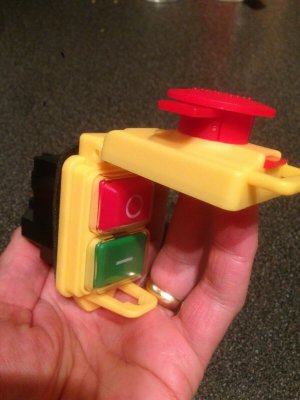You get "starters" that amount to a latched relay switch, and you get "starters" that do lots more. Some modern starters have a bunch of electronics, but are small, and incorporated into the switch. The whole point is to have swiching that wont end up in a welded up mess!
So why do you need a fat double contacts, or even solid state switch?
The reasoning goes like this..
You are (suddenly) connecting power to a motor which is standing still. It is a magnetic thing built of copper, and iron, and insulation, and like electric-magnetic things, only has any energy storage and exchange properties when things are on the move. The fields have to be changing (AC) and the rotor has to be turning.
Stood still, at the instant you slam the switch, the motor looks like the nearest thing there is to a short-circuit! The copper wires are thick, and the very few ohms, or fractions of ohms, of DC resistance in them will allow a huge surge of current. It can be 10x or 20x, or even 50x the normal rated current. It can pop trips out unless they have arrangements to delay some milliseconds.That is why we have (in UK) Class C trips used for motor inductive loads.
Once a motor is spinning, the iron has magnetic energy stored, and is generating back-emf. Without expanding on the detail about Lenz's law , the spinning rotor is also a
generator, making a voltage that tries to send current in the opposite direction (i.e. "backwards"). This is called the "back-emf", which subtracts from the voltage you apply, and the motor is left to spin on the difference, the applied voltage being the winner. With a light or no load, the back emf can nearly equal the forward voltage. As you load the shaft, the back emf becomes less, so the current increases.
The problems come when you try to switch OFF. Taking away the forward voltage leaves the rotor spinning, with inertia, making a
very high voltage that can splat, burn and weld together switch contacts. Using a starter relay moves a short copper bar with a contact at each end, and they let go together, minimizing or preventing altogether that mad splat.
Usually, a starter switch allows a "ON" momentary contact switch, which has a contact to keep the power on the relay after you let go the button "latched", and a "OFF" momentary normally closed switch in series with the relay coil to let it drop out, and this can be in series with a big red knob E-stop switch. E for "emergency". The whole thing can be quite small. This is a 260V rated 16A version I bought for a 1100W saw motor. It cheats on not having a separate the E-Stop by pressing onto the OFF button from outside the plastic lid.
 Going solid state
Going solid state
Ahh - the SOFT start! Using a solid state switch, even with a latch relay, eliminates the contacts altogether. Solid state switches that have electronics to dial up the power stop that violent jerk on high power tools like saws, and eliminate the huge surge on the power.
Milliseconds timing helps
There is one clever trick that can nearly eliminate the switch-on surge. The type of solid state relay used for ON-OFF switching (as opposed to power control) waits for the mains cycle to be at zero before turning on, so-called "zero crossing" switching. This is not the best for motor switching. If instead, the electronics waits until 12% or 15%
after the peak voltage in the mains cycle, the voltage driving the inrush current is headed toward zero. As it passes zero, and reverses, the magnetic field storage is established in the iron, the inductance becomes effective, with no drama. I used this trick to reduce a huge surge near 12x to a become a little 5% bump in the current.
Granted, the stuff we usually have in a typical HM shop is "small motor", though large enough to benefit from some care in starting and stopping. Hitting a 415V 3-phase with a direct line contactor start on a 110kW motor has it try to tear itself up out of the concrete mounts, but I saw it attempted. I spend a while, and a goodly chunk of client money installing decent motor control electronics for start-up, and a set of resistors that looked like room heaters, to brake it sweetly to a stop.






